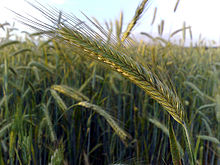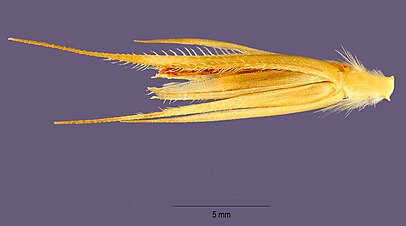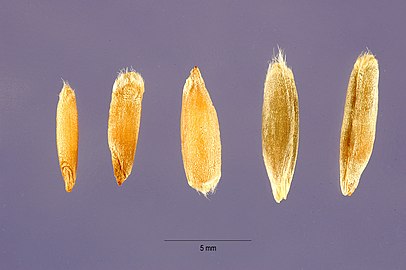Rye
| Rye | |
|---|---|

| |
| Scientific classification | |
| Kingdom: | Plantae |
| Clade: | Tracheophytes |
| Clade: | Angiosperms |
| Clade: | Monocots |
| Clade: | Commelinids |
| Order: | Poales |
| Family: | Poaceae |
| Subfamily: | Pooideae |
| Genus: | Secale |
| Species: | S. cereale
|
| Binomial name | |
| Secale cereale | |
| Synonyms | |
|
Secale fragile | |
Rye (Secale cereale) is a
Rye is a cereal grain and should not be confused with unrelated ryegrass (Lolium), which is used for lawns, pasture, and as hay for livestock.
Distribution and habitat

Rye is one of a number of
Domesticated rye occurs in small quantities at a number of Neolithic sites in Asia Minor (Anatolia, now Turkey), such as the Pre-Pottery Neolithic B Can Hasan III near Çatalhöyük,[4][5] but is otherwise absent from the archaeological record until the Bronze Age of central Europe, c. 1800–1500 BCE.[6] It is possible that rye traveled west from Asia Minor as a minor admixture in wheat (possibly as a result of Vavilovian mimicry), and was only later cultivated in its own right.[7] Archeological evidence of this grain has been found in Roman contexts along the Rhine and the Danube and in Ireland and Britain.[8] Roman naturalist Pliny the Elder was dismissive of a grain that may have been rye, writing that it "is a very poor food and only serves to avert starvation".[9] He said it was mixed with spelt "to mitigate its bitter taste, and even then is most unpleasant to the stomach".[10]
Rye grows better than any other cereal in heavy clay and light sandy soil, and infertile or drought-affected soils. It can tolerate pH between 4.5 and 8.0, but soils having pH 5.0 to 7.0 are best suited for rye cultivation. Rye grows best in fertile, well-drained loam or clay-loam soils.[12]
Frost resistance
S. cereale can thrive in subzero environments. The leaves of winter rye produce various antifreeze polypeptides (different from the antifreeze polypeptides produced by some fish and insects).[13]
Ecology
The nematode
Diseases
Rye is highly susceptible to the
After an absence of 60 years,
Rye was the
Invasiveness
Rye is a common,
Cultivation

Since the Middle Ages, people have cultivated rye widely in Central and Eastern Europe. It serves as the main bread cereal in most areas east of the France–Germany border and north of Hungary. In Southern Europe, it was cultivated on marginal lands.[22]
Rye grows well in much poorer soils than those necessary for most cereal grains. Thus, it is an especially valuable crop in regions where the soil has sand or peat. Rye plants withstand cold better than other small grains do. Rye will survive with snow cover that would otherwise result in winter-kill for winter wheat. Most farmers grow winter ryes, which are planted and begin to grow in autumn. In spring, the plants develop and produce their crop.[17]
Autumn-planted rye shows fast growth; by the
Physical properties of rye affect attributes of the final food product such as seed size and surface area, and porosity. The surface area of the seed directly correlates to the drying and heat transfer time.[23] Smaller seeds have increased heat transfer, which leads to lower drying time. Seeds with lower amounts of porosity also have lower tendencies to lose water during the process of drying.[23]
Diversity and use
Along with S. cereale's relationship and impact on the environment, it is also a valuable species because of its expansive diversity and uses. In northern Portugal, fourteen different populations of S. cereale were analyzed in order to better understand their differences. It was discovered that the storage proteins are very diverse and possess a lot of overall genetic variation as well, which is useful information to know because scientists can use its diversity in breeding to produce the most efficient
Along with improved wheat, the optimal characteristics of S. cereale can also be combined with another perennial rye, specifically S. montanum Guss, in order to produce S. cereanum, which has the beneficial characteristics of each. The hybrid rye (S. cereanum) can be grown in all environments, even with less than favorable soil and protects some soils from erosion. In addition, the plant mixture has improved forage and is known to contain digestible fiber and protein.[26] Information about the diversity, the genome[27] and S. cereanum's ability to cross fertilize with other species is useful information for scientists to know as they attempt to come up with various plant species that will be able to feed humanity in the future without leaving a negative footprint on the environment.[citation needed]
The 1R chromosome is the source of many
Li et al., 2021 provides a
Harvesting
The harvesting of rye is similar to that of wheat. It is usually done with combine harvesters, which cut the plants, thresh and winnow the grain, and release the straw to the field where it is later pressed into bales or left as soil amendment. The resultant grain is stored in local silos or transported to regional grain elevators and combined with other lots for storage and distant shipment. Before the era of mechanised agriculture, rye harvesting was a manual task performed with scythes or sickles.[31][32] The cut rye was often shocked for drying or storage, and the threshing was done by manually beating the seed heads against a floor or other object.[citation needed]
Production and consumption statistics



Rye is grown primarily in Eastern, Central and Northern Europe. The main rye belt stretches from northern Germany through Poland, Ukraine, Belarus, Lithuania and Latvia into central and northern Russia. Rye is also grown in North America (Canada and the United States), in South America (Argentina, Brazil and Chile), in Oceania (Australia and New Zealand), in Turkey, in Kazakhstan and in northern China.[citation needed]
| Producer | 2022[34] | 2020[34] | 2018[34] | 2016[34] | 2014[34] |
|---|---|---|---|---|---|
| 7,450,920 | 8,939,510 | 6,141,040 | 7,400,686 | 8,890,726 | |
| 3,132,300 | 3,513,400 | 2,201,400 | 3,173,800 | 3,854,400 | |
| 2,337,130 | 2,929,930 | 2,126,570 | 2,199,578 | 2,792,593 | |
| 2,178,808 | 2,377,629 | 1,916,056 | 2,547,878 | 3,280,759 | |
| 750,000 | 1,050,702 | 502,505 | 650,908 | 867,075 | |
| 691,470 | 699,370 | 476,590 | 577,200 | 677,800 | |
| 520,177 | 487,800 | 236,400 | 436,000 | 217,500 | |
| 500,767 | 512,591 | 504,698 | 545,657 | 520,000 | |
| 314,030 | 456,780 | 393,780 | 391,560 | 478,000 | |
| 312,460 | 292,930 | 214,180 | 290,379 | 182,610 | |
| 242,207 | 72,450 | 95,366 | 48,563 | 55,899 | |
| 225,510 | 221,201 | 86,098 | 60,676 | 52,130 | |
| 188,880 | 407,620 | 404,280 | 377,355 | 290,970 | |
| World total | 13,143,055 | 15,036,812 | 10,702,482 | 12,999,144 | 15,204,158 |
Production levels of rye have fallen since 1992 in most of the producing nations, as of 2022[update]. For instance, production of rye in Russia fell from 13.9 million
World trade of rye is low compared with other grains such as wheat. The total export of rye for 2016 was $186M[36] compared with $30.1B for wheat.[37]
Poland consumes the most rye per person at 32.4 kg (71 lb) per capita (2009). Nordic and Baltic countries are also very high. The EU in general is around 5.6 kg (12 lb) per capita. The entire world only consumes 0.9 kg (2 lb) per capita.[38]
Uses

Rye grain is refined into a
Rye grain is used to make alcoholic drinks, such as
Rye flour is used in the original way to make
Rye grain (aka "Rye Berries") is a popular medium to use as a grain spawn when cultivating some varieties of edible mushrooms. The grain is cleaned, hydrated, and sterilized and then injected with mushroom spores and the mycelium grow using the grain to obtain water and nutrients.
Food
| Nutritional value per 100 g (3.5 oz) | |
|---|---|
| Energy | 1,414 kJ (338 kcal) |
75.86 g | |
| Sugars | 0.98 g |
| Dietary fiber | 15.1 g |
1.63 g | |
10.34 g | |
Niacin (B3) | 25% 4 mg |
| Pantothenic acid (B5) | 20% 1 mg |
| Vitamin B6 | 18% 0.3 mg |
| Folate (B9) | 10% 38 μg |
| Choline | 5% 30 mg |
| Vitamin E | 7% 1 mg |
| Vitamin K | 5% 6 μg |
| Minerals | Quantity %DV† |
| Calcium | 2% 24 mg |
| Iron | 17% 3 mg |
| Magnesium | 26% 110 mg |
| Manganese | 130% 3 mg |
| Phosphorus | 27% 332 mg |
| Potassium | 17% 510 mg |
| Sodium | 0% 2 mg |
| Zinc | 27% 3 mg |
| Other constituents | Quantity |
| Water | 10.6 g |
| Selenium | 14 µg |
| †Percentages estimated using US recommendations for adults,[43] except for potassium, which is estimated based on expert recommendation from the National Academies.[44] | |
Nutrition
A 100-gram (3+1⁄2-ounce) reference serving of rye provides 1,410 kilojoules (338 kilocalories) of
Health effects
According to
Eating whole-grain rye, as well as other high-fibre grains, improves regulation of
Health concerns
Like wheat, barley, and their hybrids and derivatives, rye contains
Ergotism is an illness that can result from eating rye and other grains infected by ergot fungi (which produce ergoline toxins in infected products). Although it is no longer a common illness because of modern food safety efforts, it was common before the 20th century, and it can still happen today if food safety vigilance breaks down.[51]
Hybridization
Rye has long been considered an inferior grain to wheat in quality and digestibility, but has far larger seeds and is hardier. In the 19th century, efforts were made to create a hybrid with the best qualities of both, known initially as triticosecale, but eventually becoming known as triticale. Initially fraught with fertility and germination problems, triticale is becoming more common worldwide in the 21st century, with millions of acres/hectares being produced.[citation needed]
Gallery
-
Seed in husk
-
Different types
-
1878 oil painting A Rye Field by Ivan Shishkin
References
- ^ "Forage Identification: Rye". University of Wyoming: Department of Plant Sciences. September 26, 2017. Archived from the original on August 18, 2017. Retrieved September 26, 2017.
- from the original on November 20, 2021. Retrieved July 12, 2016.
- S2CID 129087203.
- (subscription required)
- PMID 30921415.
- ISBN 978-0-19-954906-1. Retrieved October 5, 2016 – via Google Books.
- S2CID 86549764.
- ^ Gyulai, Ferenc (2014). "Archaeobotanical overview of rye (Secale Cereale L.) in the Carpathian-basin I. from the beginning until the Roman age". Journal of Agricultural and Environmental Science. 1 (2): 25–35. Archived from the original on December 31, 2019. Retrieved July 14, 2016. page 26.
- ISBN 978-0-521-23793-2. Archivedfrom the original on May 26, 2020. Retrieved November 15, 2015 – via Google Books.
- Taylor and Francis (T&F). Book 18, Ch. 40. Archived from the original on January 6, 2017. Retrieved July 12, 2016 – via Perseus Digital Library, Trufts University.
- .
- ISBN 978-1-84826-368-0. Archivedfrom the original on May 11, 2021. Retrieved December 4, 2020.
- PMID 12232141.
- ISBN 978-0-442-30830-8. Retrieved July 14, 2016 – via Google Books.
- ^ ergot Archived March 3, 2016, at the Wayback Machine, online medical dictionary
- Dorland's Medical Dictionary
- ^ a b Wong, George J. (1998). "Ergot of Rye: History". Botany 135 Syllabus. University of Hawaiʻi at Mānoa, Botany Department. Archived from the original on November 24, 2005. Retrieved July 12, 2016.
- ^ Petruzzello, Melissa. "Ergot". Britannica. Encyclopædia Britannica, Inc. Archived from the original on February 12, 2019. Retrieved March 3, 2019.
- ^ a b c
- Multiple sources:
- • Annika, Djurle; Young, Beth; Berlin, Anna; Vågsholm, Ivar; Blomstrom, Anne; Nygren, Jim; Kvarnheden, Anders (2022). "Addressing biohazards to food security in primary production". S2CID 249244042. 882440.
- ^
- Ellis JG, Lagudah ES, Spielmeyer W, Dodds PN (2014). "The past, present and future of breeding rust resistant wheat". Frontiers in Plant Science. 5: 641. PMID 25505474.
- Published by Frontiers but cited by Brown 2015 & Uauy 2017.
- Ellis JG, Lagudah ES, Spielmeyer W, Dodds PN (2014). "The past, present and future of breeding rust resistant wheat". Frontiers in Plant Science. 5: 641.
- University of Nebraska, Lincoln Extension. Archived from the originalon April 13, 2014. Retrieved July 12, 2016.
- from the original on March 23, 2022. Retrieved February 17, 2022.
- ^ a b
- Jouki, Mohammad; Emam-Djomeh, Zahra; Khazaei, Naimeh (2012). "Physical Properties of Whole Rye Seed (Secale cereal)". International Journal of Food Engineering. 8 (4). S2CID 102003836.
- Species binomial misspelled in original.
- Jouki, Mohammad; Emam-Djomeh, Zahra; Khazaei, Naimeh (2012). "Physical Properties of Whole Rye Seed (Secale cereal)". International Journal of Food Engineering. 8 (4).
- PMID 22568702.
- S2CID 16421403.
- ISSN 0133-3720.
- PMID 27888547.
- ^ a b
Herrera, Leonardo; Gustavsson, Larisa; Åhman, Inger (2017). "A systematic review of rye (Secale cereale L.) as a source of resistance to pathogens and pests in wheat (Triticum aestivum L.)". PMID 28559761.
- ^ SeCan. (2014). AC® Hazlet. Retrieved from "Archived copy" (PDF). Archived from the original (PDF) on March 4, 2016. Retrieved November 28, 2014.
{{cite web}}: CS1 maint: archived copy as title (link) - ^
- Rabanus-Wallace, M.; Stein, Nils (2021). The Rye Genome. ISBN 978-3-030-83383-1.
- This book cites this research.
- Li, Guangwei; Wang, Lijian; Yang, Jianping; et al. (2021). "A high-quality genome assembly highlights rye genomic characteristics and agronomically important genes". S2CID 232298036.
- Rabanus-Wallace, M.; Stein, Nils (2021). The Rye Genome.
- ISBN 978-0-300-04265-8. Retrieved July 17, 2016 – via Google Books.
- ISBN 978-0-19-102515-0. Retrieved July 17, 2016 – via Google Books.
- ^ Harvard Atlas of Economic Complexity
- ^ a b c d e f "FAOSTAT". www.fao.org. Retrieved March 1, 2024.
- ^ "Crops and livestock products". FAOSTAT. Food and Agriculture Organization of the United Nations.
- ^ "OEC - Countries that export Rye (2016)". Archived from the original on March 23, 2022. Retrieved October 22, 2017.
- ^ "OEC - Countries that export Wheat except durum wheat, and meslin (2016)". Archived from the original on March 23, 2022. Retrieved October 22, 2017.
- ^ "Statistics and Usage - www.ryeandhealth.org". Archived from the original on June 15, 2018. Retrieved October 22, 2017.
- .
- ^ "Grains: Rye" Archived November 13, 2018, at the Wayback Machine (in Dutch) bakkerijmuseum.nl
- PMID 11415489.
- ^ "Swedish Red Paint - Falu Röd". Archived from the original on September 25, 2020. Retrieved March 25, 2021.
- ^ United States Food and Drug Administration (2024). "Daily Value on the Nutrition and Supplement Facts Labels". Retrieved March 28, 2024.
- )
- ^ "21 CFR Part 101 [Docket No. 2004P-0512], Food Labeling: Health Claims; Soluble Dietary Fiber From Certain Foods and Coronary Heart Disease". US Food and Drug Administration. May 22, 2006. Archived from the original on February 24, 2021. Retrieved December 2, 2015.
- ^ "Summary of Health Canada's Assessment of a Health Claim about Barley Products and Blood Cholesterol Lowering". Health Canada. July 12, 2012. Retrieved November 27, 2022.
- S2CID 29100975.
- PMID 25225349.
- PMID 25789300.
- PMID 22237879.
- S2CID 26814635.
Further reading
- Schlegel, Rolf (2006). "Rye (Secale cereale L.): A Younger Crop Plant with Bright Future". In Sing, R. J.; Jauhar, P. (eds.). Genetic Resources, Chromosome Engineering, and Crop Improvement. Vol. II–Cereals. Boca Raton, Florida: ISBN 978-0-8493-1430-8. Schlegel provides a 2011 updated versiononline.
External links
- Schlegel, Rolf; Korzun, V. (2016). "Genes, Markers, and Linkage Data of Rye (Secale cereale L.)". 08.16. Retrieved July 12, 2016.
- Schlegel, Rolf (2016). "Current List of Wheats with Rye and Alien Introgression". Rye-Gene-Map.de. 05.16. Retrieved July 12, 2016.
- "Growing Rye". December 1959. Retrieved July 12, 2016 – via University of North Texas Library, Government Documents Department.
- " Multilingual taxonomic information". University of Melbourne.




